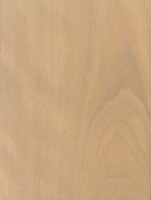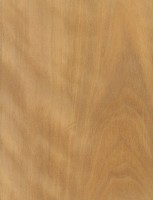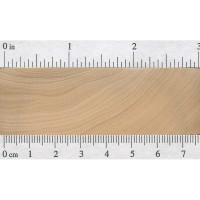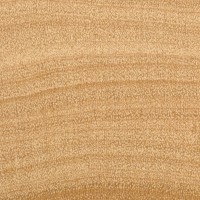 |
Common Name(s): Lemonwood, Degame Scientific Name: Calycophyllum candidissimum Distribution: Cuba and Central America Tree Size: 40-80 ft (12-24 m) tall, 1-2 ft (.3-.6 m) trunk diameter Average Dried Weight: 51 lbs/ft3 (810 kg/m3) Specific Gravity (Basic, 12% MC): .67, .81 Janka Hardness: 1,880 lbf (8,350 N) Modulus of Rupture: 22,100 lbf/in2 (152.4 MPa) Elastic Modulus: 2,284,000 lbf/in2 (15.75 GPa) Crushing Strength: 9,790 lbf/in2 (67.5 MPa) Shrinkage: Radial: 4.8%, Tangential: 8.6%, Volumetric: 13.2%, T/R Ratio: 1.8 |
Color/Appearance: Heartwood is a light brown to pale yellowish color. Sapwood is lighter in color and isn’t clearly demarcated form the hartwood.
Grain/Texture: Grain tends to be straight to slightly interlocked. Fine, uniform texture with a slightly lustrous appearance.
Endgrain: Diffuse-porous; solitary and radial multiples of 2-4 or more; small pores in no specific arrangement, numerous to very numerous; parenchyma absent; narrow rays not visible without lens, spacing fairly close.
Rot Resistance: Mixed reports depending on type of decay fungi; usually rated as moderately durable. Excellent resistance to marine borers.
Workability: Overall working properties are fair, though dry wood is reported to have a high cutting resistance. Lemonwood turns, glues, and finishes well.
Odor: No characteristic odor.
Allergies/Toxicity: Besides the standard health risks associated with any type of wood dust, no further health reactions have been associated with Lemonwood. See the articles Wood Allergies and Toxicity and Wood Dust Safety for more information.
Pricing/Availability: Most quality trees are primarily grown in Cuba, so the wood can be difficult to obtain due to trade restrictions. Lemonwood is sometimes seen for sale as turning blanks, bow stave blanks, and veneer. Prices are likely to be moderately high for an imported wood.
Sustainability: This wood species is not listed in the CITES Appendices or on the IUCN Red List of Threatened Species.
Common Uses: Archery bows, carvings, turned objects, and fishing rods.
Comments: Not to be confused with the wood from actual lemon trees (Citrus limon), which is not regularly used in woodworking applications. Lemonwood is sometimes referred to as Degame.
Lemonwood has a very good MOR-to-weight ratio, and generally possesses good strength properties, which explains its use in archery bows and fishing rods.
None available.
Scans/Pictures: A special thanks to Steve Earis for providing the wood sample of this wood species.








Hola que tal soy de Colombia quiero preguntar la madera de limón será buena para fabricar arcos
Hola Julian, también me llamo Julian. Madera de limón si funciona muy bien para los arcos. Lo más importante en un pedazo es que las fibras son rectas y cerca. Con esta tipa de fibra, esta madera (ellos lo llamaba “degame”) fue usado para los arcos famoso en Inglaterra en los 1600s-1800s, los arcos de deportes similares a los arcos de guerra que fueron usado en los 1100s. Si las fibras en su madera no son perfectas, también puedes usar una madera blanca como una espalda para mejorar la estabilidad. Una cosa final – si cortas un árbol de madera… Read more »
Is lemonwood safe to use for a cutting board? I don’t think it is the fruit variety. If not I will use the beautiful wood for the handles of the fishing nets that I build.
Certainly safe, but for a cutting board your seeking ‘toughness;’ I’d suggest a harder wood, such as oak or hickory. Lemon I’d equate with Poplar on the’ toughness’ scale. It’s feature is it’s ‘consistency’ when carving; not something you need when slabbing together a cutting board IMHO. Also, the Lemon wood will stain too easily IMHO.
Lemonwood is a lot harder than oak or hickory.
Nothing to do with lemons, this tree.
But de correct spanish name is DAGAME or DÁGAME, and other names as SALAMO, CAMARÓN… but never degame.
Lee, I know it´s been used, at least in Spain, for backpipes, flutes, ando other musical instruments.
Some craftsman told me about the good sound cuality of this wood.
I have been warned about the high cut resistance of lemon wood, but having seen an ideal blank in my local yard I might consider it for an electric guitar body, any idea what’s tonal quality is like?
Thanks in advance.
The ‘tonal’ quality of non-acoustic guitar bodies is mythical IMHO; sorry. (But it sells a lot of Walnut guitars at triple the price). As for the NECK of the guitar… now that’s a different story. It would be good for body, and be similar to ‘clear’ Poplar, and note the emphasis on ‘clear,’; that is the feature of the Lemon wood; it’s ALL clear.
Is lemon tree wood good as a firewood??
Are you referring to lemonwood (the wood species on this page) or the actual tree that yields the lemon fruit (different species)?
Sure; all wood but Eucalyptus, and sappy pine is great for burning (they pop, and blow debris everywhere). You’d probably have to go to Cuba to find any volumn of ‘Lemon’ IMHO. It’s known for it’s ‘white,’ consistent grain, and thus consistent carving ability. You like to whittle? Get some Lemon wood.
Did you find out whether lemon wood is good for firewood please picking some up tomorrow!